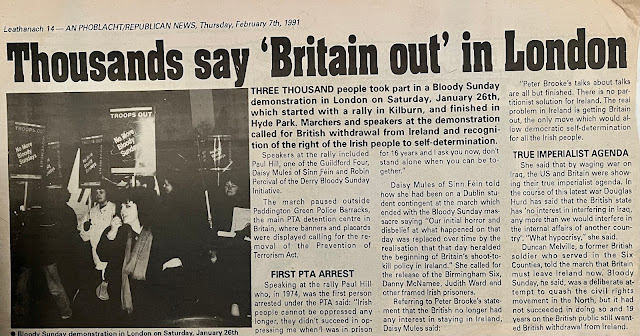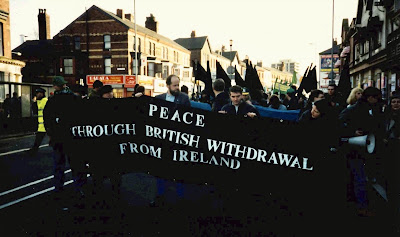The Trammps' disco classic The Night the Lights Went Out (1977) commemorates an actual historical event in that year - the
New York blackout. In The Trammps' account this was an occasion for sex in the unlit darkness:
Where were you when the lights went out
In New York City (I wanna know, I wanna know)
Where were you when the lights went out
In New York City
Don't you know that I was making love
(She was making love)
I remember on the 13th of July
The only light was the light up in the sky
New York had black-out for 25 hours or more
And nobody really knows the reason why...
Politicians said it was a pity
But that was the night they call it love city
So I took my lady by the hand
And led her to love me, love me, love me!
Where were you when the lights went out
In New York City (I wanna know, yeah)
Where were you when the lights went out
In New York City
But sex wasn't the only thing on New Yorkers' minds - the power cut also prompted mass looting. John Zerzan celebrated this aspect in an article published in the Detroit-based radical paper Fifth Estate (August 1977):
New York, New York
“Amid All the Camaraderie is Much Looting this Time; Seeing the City Disappear”, Wall Street Journal headline, 15 July 1977
The Journal went on to quote a cop on what he saw, as the great Bastille Day break-out unfolded: “People are going wild in the borough of Brooklyn. They are looting stores by the carload.” Another cop added later: “Stores were ripped open. Others have been leveled. After they looted, they burned.”
At about 9:00 p.m. on July 13 the power went out in New York for 24 hours. During that period the complete impotence if the state in our most ‘advanced’ urban space could hardly have been made more transparent. As soon as the lights went out, cheers and shouts and loud music announced the liberation of huge sections of the city. The looting and burning commenced immediately, with whole families joining in the “carnival spirit”. In the University Heights section of the Bronx, a Pontiac dealer lost the 50 new cars in his showroom. In many areas, tow trucks and other vehicles were used to tear away the metal gates from stores. Many multistorey furniture businesses were completely emptied by neighborhood residents.
Despite emergency alerts for the state troopers, FBI and National Guard, there was really nothing authority could do, and they knew it. A New York Times editorial of July 16 somewhat angrily waved aside the protests of those who wondered why there was almost no intervention on the side of property. “Are you kidding?” the Times snorted, pointing out that such provocation would only have meant that the entire city would still be engulfed in riots, adding that the National Guard is a “bunch of kids” who wouldn’t have had a chance.
The plundering was completely multi-racial, with white, black and Hispanic businesses cleaned out and destroyed throughout major parts of Manhattan, Brooklyn, Queens and the Bronx. Not a single “racial incident” was reported during the uprising, while newspaper pictures and TV news bore witness to the variously coloured faces emerging from the merchants’ windows and celebrating in the streets. Similarly, looting, vandalism, and attacks in police were not confined to the City proper; Mount Vernon, Yonkers and White Plains were among suburbs in which the same things happened, albeit on a smaller scale.
Rioting broke out in the Bronx House of Detention where prisoners started fires, seized dormitories, and almost escaped by ramming through a wall with a steel bed. Concerning the public, the Bronx District Attorney fumed, “It’s lawlessness. It’s almost anarchy.”
Officer Gary Parlefsky, of the 30th Precinct in Harlem, said that he and other cops came under fire from guns, bottles and rocks. He continued: 'We were scared to death... but worse than that, a blue uniform didn’t mean a thing. They couldn’t understand why we were arresting them'.
At a large store at 110th Street and Eighth Avenue, the doors were smashed open and dozens of people carried off appliances. A woman in her middle-50s walked into the store and said laughingly: “Shopping with no money required!”
Attesting to the atmosphere of a “collective celebration”, as one worried columnist put it, a distribution center was spontaneously organized at a Brooklyn intersection, with piles of looted goods on display for the taking. This was shown briefly on an independent New York station, WPIX-TV, but not mentioned in the major newspapers. The transformation of commodities into free merchandise was only aided by the coming of daylight, as the festivity and music continued. Mayor Beame, at a noon (July 15) press conference, spoke of the “night of terror”, only to be mocked heartily by the continuing liberation underway throughout New York as he spoke.
Much, of course, was made of the huge contrast between the events of July 1977 and the relatively placid, law-abiding New York blackout of November 1965. One can only mention the obvious fact that the dominant values are now everywhere in shreds. The “social cohesion” of class society is evaporating. New York is no isolated example.
Of course, there has been a progressive decay in recent times of restraint, hierarchy, and other enforced virtues; it hasn’t happened all at once. Thus, in the 1960s, John Leggett (in his Class, Race and Labour) was surprised to learn upon examining the arrest records of those in the Detroit and Newark insurrections, that a great many of the participants were fully employed. This time, of the 176 people indicted as of August 8 in Brooklyn (1,004 were arrested in the borough), 48% were regularly employed. (The same article in the August 9 San Francisco Chronicle where these figures appeared also pointed out that only “six grocery stores were looted while 39 furniture stores, 20 drug stores and 17 jewelry stores and clothing stores were looted”). And there are other similarities to New York, naturally; Life magazine of 4 August 1967 spoke of the “carnival-like revel of looting” in Detroit, and Professor Edward Banfield commented that "Negroes and whites mingled in the streets [of Detroit] and looted amicably side by side....”
The main difference is probably one of scale and scope — that in New York virtually all areas, even the suburbs, took the offensive and did so from the moment the lights went out. Over $1 billion was lost in the thousands of stores looted and burned, while the cops were paralyzed. During the last New York rioting, the ‘Martin Luther King’ days of 1968, 32 cops were injured; in one day in July 1977, 418 cops were injured.
The Left — all of it — has spoken only of the high unemployment, the police brutality; has spoken of the people of New York only as objects, and pathetic ones at that! The gleaming achievements of the unmediated / unideologized have all the pigs scared shitless'.






































